 Leading Blog | Posts by Month |
 Leading Blog | Posts by Month |
03.31.22

LeadershipNow 140: March 2022 Compilation
See more on
Posted by Michael McKinney at 01:42 PM

Leading Thoughts for March 31, 2022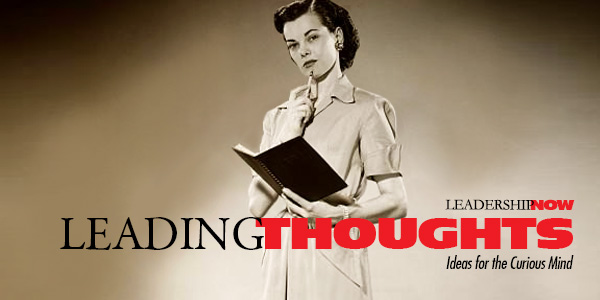
IDEAS shared have the power to expand perspectives, change thinking, and move lives. Here are two ideas for the curious mind to engage with: Richard Rumelt on listening: “When another person speaks, you hear both less and more than they mean. Less because none of us can express the full extent of our understanding, and more because what another says is constantly mixing and interacting with your own knowledge and puzzlements.” Source: Good Strategy Bad Strategy: The Difference and Why It Matters Ram Charan on leadership: “Leadership matters. It creates and harnesses the energy of people, gives them direction, and synchronizes their efforts. In fact, it is a leading indicator of a company’s prospects, unlike financial results, which tell you only where the company has already been. Strong leadership makes a good company better just as surely as weak leadership lowers its prospects and over time ruins it.” Source: Leaders at All Levels: Deepening Your Talent Pool to Solve the Succession Crisis Look for these ideas every Thursday on the Leading Blog. Find more ideas on the LeadingThoughts index.
Posted by Michael McKinney at 08:03 AM
03.24.22

Leading Thoughts for March 24, 2022
IDEAS shared have the power to expand perspectives, change thinking, and move lives. Here are two ideas for the curious mind to engage with: Sebastian Mallaby on forecasting the future: “The revolutions that will matter—the big disruptions that create wealth for investors and anxiety for workers, or that scramble the geopolitical balance and alter human relations—cannot be predicted based on extrapolations of past data, precisely because such revolutions are so thoroughly disruptive. Rather, they will emerge as a result of forces that are too complex to forecast—from the primordial soup of tinkerers and hackers and hubristic dreamers—and all you can know is that the world in ten years will be excitingly different. Mature, comfortable societies, dominated by people who analyze every probability and manage every risk, should come to terms with a tomorrow that cannot be foreseen. The future can be discovered by means of iterative, venture-backed experiments. It cannot be predicted.” Source: The Power Law: Venture Capital and the Making of the New Future Jeffrey Sutton and Robert Sutton on the relationship between knowing and doing: “There is only a loose and imperfect relationship between knowing what to do and the ability to act on that knowledge. Competitive advantage comes from being able to do something others can’t do. If you and colleagues learn from your own actions and behavior, then there won’t be much of a knowing-doing gap because you will be knowing on the basics of your doing, and implementing that knowledge will be substantially easier.” Source: The Knowing-Doing Gap: How Smart Companies Turn Knowledge into Action Look for these ideas every Thursday on the Leading Blog. Find more ideas on the LeadingThoughts index.
Posted by Michael McKinney at 01:35 PM
03.22.22

The Six Mindsets That Distinguish the Best Leaders from the Rest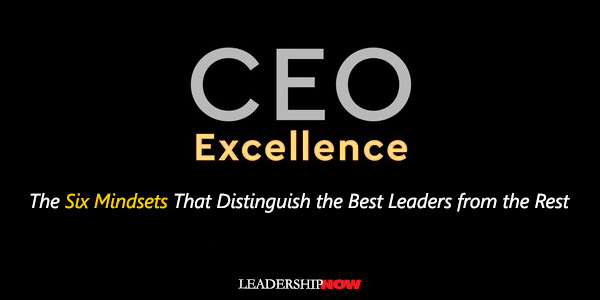
WHAT differentiates the best CEOs from the rest? There are timeless mindsets and practices that make the difference. In CEO Excellence, McKinsey partners Carolyn Dewar, Scott Keller, and Vikram Malhotra, spell out these mindsets and practices. The culmination of what they found leads to the fact that these leaders help others to achieve things they never imagined they’d be able to. So there are lessons for all leaders at any level in this book. Through their research—they found 146 CEOs that excelled in the CEO role to study but then cast a wider net to round it out to 200 top-performing CEOs—they determined that there are six mindsets that differentiated the best leaders of the twenty-first century from the rest. These mindsets enable them to navigate the dominant features of their environment—new competition, disruptive change, digitization, pressing social and environmental issues, or economic meltdowns—with wild success, while others wallow in mediocrity. The simple fact is that the top of the pack think differently, which causes them to take profoundly different actions day in and day out. The Six Mindsets The best CEOs may not be the best in these mindsets, but they are the best at integrating all of these responsibilities simultaneously. “For a CEO, what’s important is that you can balance everything together,” said KBC’s Johan Thijs. Assa Abloy’s Johan Molin added, “As CEO, you need to realize that you’re only one person, and you’re not the best person because you’re such a generalist. You’re not going to be not trying to be the smartest of the smart, but you can give good advice, facilitate, and encourage people to work.” Each mindset is associated with three practices. Setting the Direction Rather than hedging their bets, the best CEOs are bold. “They’re less a taker of their fate and more a shaper—constantly looking for and acting on opportunities that bend the curve of history.” Vision: They reframe what success means. “The best CEOs often dig back into a company’s history to find out what originally made it successful and then take that central idea and expand it in ways that open up new opportunities.” They add, “what matters to them is to have a clear and simply articulated North Star for the company that redefines success, influences decisions, and inspires people to act in desired ways.” Strategy: Move early and often. “Excellent CEOs are always looking to the next S-curve while ensuring the current one is delivered on.” Resource Allocation: Budgets are not based on last year’s budget. Resources are zero-based and then solved for the whole. “No investment is taken as a given—every investment is scrutinized, alternatives explored, and approval justified by how it helps deliver against the company’s strategy and vision.” Aligning the Organization Once the direction is set, execution is not inevitable. The problem is more than intellectual. It is an emotional one. “You have to fix both sides as the CEO: The easy part is technical; the difficult part is people.” Culture: Align the culture: reshape the work environment, make it personal, make it meaningful, and measure what matters. CEO must embody the change. Organizational Design: “When a CEO sees an organization tilted one way, there’s a temptation to tilt the opposite way—and, like the pendulum of a clock, the swing back and forth between the two polarities is perpetuated. The best CEOs rarely make radical swings from one extreme to the other.” Talent Management: “Your people decisions are really where all your leverage is,” says GE CEO Larry Culp. You must clearly define high-value roles, look for the left tackle positions that protect and enable value to be created, find the unusual suspects, and actively build the bench. Mobilizing Through Leaders The best CEOs and less concerned about what their leaders do together and more concerned about how their leaders work together. “They obsess with solving for the team’s psychology and let the mechanics of coordination and execution follow.” Team Composition: “A group of high performers only become truly high performing if its members are complementary and connected to one another and not simply working side by side.” The best CEOs staff the team with an eye to aptitude and attitude, act fast but fairly regarding those who don’t belong, stay connected while keeping their distance, and build a leadership coalition beyond their immediate team. Teamwork Effectiveness: Those on the top team have a responsibility to the organization over their own units. “I’m on the team so I can represent the company to my function or business.” Operating Rhythm: “When a CEO creates a clear and effective operating rhythm, every member of the top team can sync the rhythm of their specific area with that of the company as a whole.” As CEO, you have a 30,000-foot view of the organization. You need to make sure your team members have the advantage of that perspective. “If the CEO is not making the gears mesh together, dysfunctions quickly become hardwired.” From Microsoft’s Satya Nadella: People say the job is lonely. I realized that it’s an information asymmetry problem. Nobody who works for you sees what you see. And nobody you work for sees what you see. That’s the fundamental problem of a CEO, which is you see it all, and nobody else around you sees it, so you can get very frustrated. Engaging the Board “The best CEOs help the board chair run the board so that the directors can help the CEO run the business.” Board Relationships: The best CEOs build and maintain trust by choosing radical transparency, building a strong relationship with the board chair, reaching out to individual directors, and exposing the board to management. “Trust is not about charisma or friendship. Trust is based on delivery,” says David Thodey CEO of Telstra. Board Capabilities: Be clear about the role the board should play and make sure they understand the business. Encourage the chair to evaluate board performance. Board Meetings: Focus on the future. Serve on a board yourself to get a perspective on what it is to be a board member. Never get involved in board functions. Connecting with Stakeholders “Research shows that a company’s relationships with external stakeholders can influence as much as 30 percent of corporate earnings.” Social Purpose: Be sure your organization has a powerful reason for why they exist. We live in a time where stakeholders want to hear the CEO or organization take a stand on various social issues. “The best CEOs don’t confuse their personal passions for their company’s principles.” Stakeholder Interaction: Getting it right is not always easy, but the best CEOs share these commonalities: they contain the time spent Outside, they understand the other party’s why, they gather as many good ideas as possible from the interactions, and they maintain a single narrative across all stakeholders. Former Best Buy CEO Hubert Joly explains: The key with any stakeholder is to get the “say-do” ratio right: the ratio between what we say we were going to do and what we actually did. That’s how you get credibility. And if you’re doing what you are saying you will do, they’ll actually want to see less of you. They’ll want you to be spending your time working on the business and delivering on your commitments. Moments of Truth: Have a crisis playbook that you can tailor to each situation. When a crisis hits, maintain a long-term perspective to keep driving the business forward. Ahold Delhaize’s CEO Dick Boer says there are three lessons for CEOs when dealing with a crisis: First, do not chair or lead your crisis team. Let them report out to you. This gives you the space and time to oversee all the elements of the business, not only the crisis. Second, show confidence in your organization—show that you’re in control, that you know what you’re doing, and that you’ll take care of your people and your customers. Third, think of what’s next even when the storm is still around you, because there’ll be opportunities and other situations you have to manage as a consequence of the crisis that you might not have thought about. Managing Personal Effectiveness Leading yourself is essential to be physically and psychologically fit, and not even the best CEOs have this figured out. One executive coach said, “No one has ever lived to outwork the job. It will always be bigger than you.” Office: Managing your time and energy involves keeping a tight but loose schedule, compartmentalizing, infusing energy into your routine, and tailoring your support staff to your needs. “With so much on a CEO’s plate, one of the most challenging aspects of the job from an emotional perspective is to move from meeting to meeting without letting what happened in one spill over to sabotage the next.” Leadership Model: Show a consistency of character—authenticity. “Being consistent doesn’t mean that CEOs should be inflexible. Without betraying their core values, the best are willing and able to modify how they lead if the circumstances demand i. It’s important to figure out what kind of CEO the company needs.” Perspective: Stay grounded. The best CEOs don’t; make it all about them. They embrace servant leadership. They create a kitchen cabinet that can speak truth to power and keep them humble, and they display gratitude for the opportunity to sit in the CEO chair.

Posted by Michael McKinney at 04:33 PM
03.18.22

Take Charge of You
HOW do you get from A to B? Most of us want to evolve beyond today. A coach can help. But what do you do when you can’t afford a coach? Or the coach you want isn’t available? You learn to coach yourself. In Take Charge of You, David Novak and Jason Goldsmith say you can’t leave your personal growth to chance. But coaching yourself doesn’t mean going it alone. Instead, “it means you are constantly looking for ways to grow yourself and for anything and anyone who can help you do that.” As in any coaching situation, you begin by getting to understand who you are and what you want. What brings you joy? Where do you want to see yourself? When you choose a destination in this self-coaching process, you are choosing a direction for where you want to take your life or career in the future. Once you do that, the work becomes about planning your route, making steady progress, dealing with the inevitable potholes and roadblocks along the way, and maybe even making changes on the fly if circumstances change. It is important that you develop a coaching mindset—meaning “being open to whatever is going to drive your growth and performance.” Like a good coach, you don’t have all of the answers. So you need to be open, flexible, and ready to explore. Reframing your experiences will help you remain open to the lessons you could be learning. I liked their explanation of reframing as some people think of it as lying to yourself: Reframing isn’t an exercise in wishful thinking, and it isn’t an exercise in denying your feelings … Instead, reframing is an exercise in choosing a more productive way of thinking about anything you are up against. A big part of the self-coaching mindset is knowing your own mind. Know what thoughts are getting in your way, perhaps creating self-fulfilling prophecies in your life. What situations trigger negative thoughts? How are you responding to roadblocks? The authors provide various exercises to help you take control of your thoughts. These are all opportunities to grow. Self-coaching means taking responsibility for the ideas and insights you need to move you forward. Ask people who have done something similar to what you want to do. You don’t need to find the best in the field. You just need to find the person that knows a bit more than you now. With these insights, you can now take insightful actions—actions that are both “informed and inspired.” Make a list of all of the actions you need to take to get you closer to the person you want to be. Break them down as much as possible. Before you begin your journey, make sure you know where you are—your current reality. It is essential that you keep your eye on your goal “while you make decisions about what you want to do and where you want to go in life. Does that mean that every single thing you do will be joyful? Of course not.” You may not be doing exactly what you want to do right now, but you are learning things to help you get where you want to go. In the beginning, focus on making sure you have the experience and skills to be good at whatever it is you want to be when you get there. The path to achieving something new will always be a question mark until we walk in it. So what do we do with that question mark? We can start by admitting we won’t have all the answers up front, and we don’t need to. Always focus on the next step rather than focusing on all of the ings you have to do. Focus on the process. A consistent effort makes all of the difference. A word about setbacks: they are inevitable. Life isn’t static, so even when you master something, there will still be new obstacles to come. That’s just how life works in any field, in any industry, in any context, at any time, for any and every person out there. Every setback is an opportunity to learn a lesson and grow. It is helpful to build motivation into the process. How? Remind yourself what matters, connect with your future vision, and share your intention with others. Take Charge of You is full of helpful exercises to help you through the self-coaching process. A good portion of those exercises cover the right mindset, gaining an understanding of who you are, how you think and respond to situations. This is the tough groundwork we must go through to find that inner sense of joy we want. Do that right, and the rest becomes much easier. 
Posted by Michael McKinney at 09:18 AM
03.17.22

Leading Thoughts for March 17, 2022
IDEAS shared have the power to expand perspectives, change thinking, and move lives. Here are two ideas for the curious mind to engage with: Lawyer Michael L. King on identity: “One of my happiest childhood memories is of a ride with my father in our old clunker of an automobile. A shiny red Cadillac whizzed past and daddy remarked how pretty and expensive it was. “Why do Cadillacs cost so much money?” I asked. “Is it the name?” Source: “Fatherhood and the Black Man,” Wall Street Journal, June 6, 1988 American psychiatrist Thomas Szasz on learning: “Every act of conscious learning requires the willingness to suffer an injury to one’s self-esteem. That is why young children, before they are aware of their own self-importance, learn so easily; and why older persons, especially if vain or important, cannot learn at all.” Source: The Second Sin Look for these ideas every Thursday on the Leading Blog. Find more ideas on the LeadingThoughts index.
Posted by Michael McKinney at 07:51 AM
03.16.22

5 Leadership Lessons: The Five B’s of Purposeful Leadership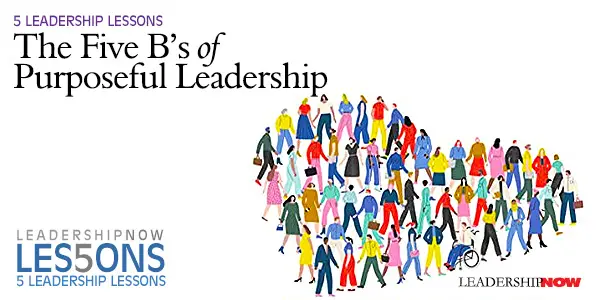
IN The Heart of Business: Leadership Principles for the Next Era of Capitalism, former CEO of Best Buy, Hubert Joly, shares the philosophy behind the resurgence of Best Buy: pursue a noble purpose, put people at the center of the business, create an environment where every employee can blossom, and treat profit as an outcome, not the goal. He shares what he learned and what he had to unlearn. How we lead matters. He concludes with the five principles of purposeful leadership that guided his leadership.
Our employees are expecting us to be human, and they expect us to grasp who they are and to make them feel respected, heard, understood, and included. This means we have to open up and make ourselves vulnerable, including by acknowledging what we do not know. 
Posted by Michael McKinney at 08:55 AM
03.14.22

Who the Hell Wants to Work for You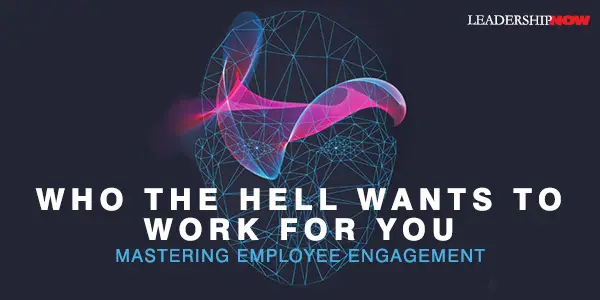
EMPLOYEE engagement is primarily a matter of how you think about your employees. It is natural think that they are generally the problem and as a result you need to “force, trick, or bribe them into mending their ways.” Tim Eisenhauer asks in Who the Hell Wants to Work for You, “What if you assumed that people naturally love to work? That they long to contribute? And they are only truly happy when working together towards something they see as bigger than themselves? If you look at it this way, there is nothing to fix. People are already wired to work with passion if … their work environment calls for it. Who is responsible for your employees’ work environment? That’s right, you are. Eisenhauer shares workplace principles that express the common needs of most people at work. These are the result of not only the lessons he has learned but those he has learned vicariously and shares through countless examples. To give you a flavor of the book, here are five: On doing something offbeat with a job candidate because you can learn so much more about people from their response to the unfamiliar than from their doctored life story: You don’t need to take every job candidate on an African safari, but do give them the chance to learn, react, process information, think on their feet, empathize, make decisions, make requests … In other words, engage in all those activities that, on a very basic level, determine success. Look for spontaneous responses. Any time you exchange canned questions and answers, you are wasting an opportunity to get to know your candidate. 
Posted by Michael McKinney at 09:08 AM
03.11.22

Compassionate Leadership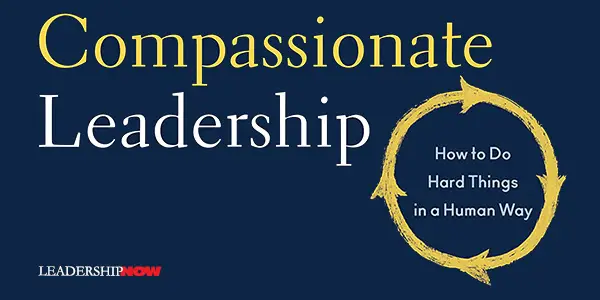
DELIVERING bad news is never easy. As a leader it is part of the job. Many of us try to avoid it or put it off. Some few relish the reputation of being tough. But being nice or being tough is not a choice we have to make. “The hardest thing for most leaders is to find the courage to enter into difficult situations with other people,” write Rasmus Hougaard and Jacqueline Carter in Compassionate Leadership. They advocate wise compassion. They break it down this way: In this regard, wisdom in leadership is about having the courage to be candid and transparent with other people and do the things that need to be done—even when it is uncomfortable. Wisdom is to see clearly that if you don’t do the hard things today, they will become even harder tomorrow. The idea is to balance wisdom (courage) and compassion and do hard things in a human way. The secret to doing this right is of course, where you as a leader are coming from. The Wise Compassion Matrix below shows the balance needed.
In Quadrant 3, at the bottom left is the indifferent and ineffective leader. They are too busy to care and often come across as unprofessional. In Quadrant 4, leaders have the courage and candor to get hard things done, but lack heart. They put results before people. Quadrant 1 is caring avoidance. We care and wee tend to avoid the hard things. “This can be out of fear of their reaction, or it can be out of empathy, which is different than compassion.” Quadrant 2 is where we want to be—Wise Compassion. Leaders in this zone balance their concern for people with the courage and candor to get the hard things done. While we tend to fall in one quadrant over another, we can operate in any of the four depending on “our relationship with the person involved, our level of busyness, or the intensity of the pressure we are facing.” To operate out of Quadrant 2 we need four skill sets that we practice in this order: 1. Caring Presence—to be here now, with the person you are with
Sounds good but it doesn’t make hard things any easier. As a said, this has to become part of you—it’s how you approach other people. The authors devote ten chapters to ten principles to help us make this part of how we lead. 1. Unlearn Management, Relearn Being Human. You must first develop sincere relationships with those you lead. “Wise compassionate leadership is about creating truly human connections between yourself and the people you lead.” 2. Great Power Comes with Great Responsibility. We have an enormous impact on the people we lead. “Therefore, when doing hard things to others, we must ensure we do them in the most human way.” 3. Connect with Empathy, Lead with Compassion. “In leadership, empathy has it’s downsides. We can have empathetic burnout or care so much that we avoid taking necessary action.” Compassion is empathy plus action. 4. Your Oxygen Mask First. “Many senior leaders are plagued by self-criticism and self-judgment.” Silencing that inner critic is key. 5. Busyness Kills Your Heart. “Busyness kills our heart and thereby our ability to do hard things in a human way.” 6. Be Here Now. “Mindfulness enables compassion.” Know yourself and how others experience you. 7. Courage Over Comfort. “Having the courage to willingly approach confrontations is one of the most important skills of wise compassionate leaders.” 8. Direct Is Faster. “We must hold people accountable while maintaining a level of compassion.” We apply caring directness, “so people receive necessary messages quickly, enabling real conversations to begin.” 9. Clarity Is Kindness. “If we are clear and open, it helps create a culture of transparency that fosters a greater sense of psychological safety.” 10. The Only Way Out is Through. Practice is required to make this thinking a reality. “By stepping into a difficult situation and coming out on the other side with a little more wisdom and a little more compassion, we become more skillful at doing the hard things necessary to lead in a wise compassionate way.” 
Posted by Michael McKinney at 08:05 AM
03.10.22

Leading Thoughts for March 10, 2022
IDEAS shared have the power to expand perspectives, change thinking, and move lives. Here are two ideas for the curious mind to engage with: Julie Winkle Giulioni on career development: “We have come to believe that career development is exclusively about the climb up and around the corporate structure. And because we’ve accepted this limited view of career development, we too are blind to the broader definition of the experience, the enormous possibilitities that are present, and the many other ways you as a manager can help employees succeed and grow. Source: Promotions Are So Yesterday: Redefine Career Development. Help Employees Thrive Phil Nolan, former CEO of Eir, on distributed leadership: “The concept of distributed leadership will keep you in touch with the environment. If you want to prepare people for this environment, you have to get leadership further down the organization. We generally tend to drive managing down the organization, but not leadership. As an organization, we have to prepare for acts of leadership further down the organization. I think that that is the hardest thing for us to do as people sitting at the top. It feels like an unnatural act.” Source: A Time for Leadership Look for these ideas every Thursday on the Leading Blog. Find more ideas on the LeadingThoughts index.
Posted by Michael McKinney at 08:38 AM
03.09.22

My Dad’s Seven Principles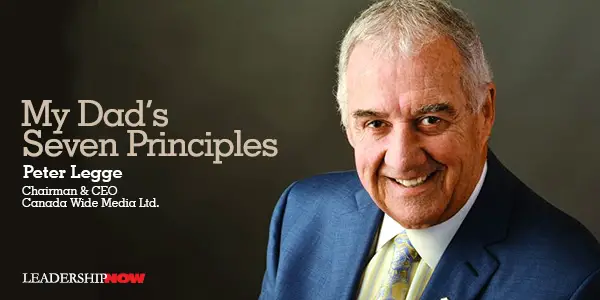
WHENEVER I have to opportunity to hear Peter Legge speak, I take it. Always interesting and practical. Recently he shared the following from his father: My father Bernie Legge had a well-developed philosophy about success, which was based on seven basic principles. When I was 11 years old, he sat me down and shared them with me, and I have since shared them with countless others. Let me share them with you.
Finally, my father liked to quote Sir Winston Churchill when he famously said, “Sometimes it’s not enough that we do our best, we must do what is required.” Speaker and the author of 23 books, Peter Legge is the Chairman & CEO of the largest, independently owned media publishing company in Western Canada – Canada Wide Media Limited. Peter learned from his father that the best reward is service to the community. Peter has received two honorary doctorate degrees from Simon Fraser University and Royal Roads University, an honorary doctorate of technology from BCIT and an honorary fellow from Douglas College. In June of 2008, Peter was presented with the highest honour in his province, The Order of British Columbia, for his lifelong commitment to the community. You can contact him at PeterLegge.com or phone at (604) 299-7311
Posted by Michael McKinney at 07:41 AM
03.07.22

Redefining Ambition and Career Development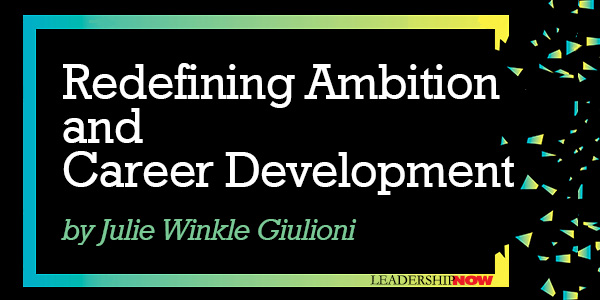
MANY definitions of “leadership” exist; but the ones that always resonate for me involve an element of bringing people along, helping them grow and progress, facilitating the development of them as people and their careers. And I have the feeling that similar definitions are deeply held by many leaders – especially given the frequency of one question I’m asked over and over: “What should I do with my ‘I’m good where I am’ employee who lacks ambition, doesn’t seem to want to grow, and is completely disinterested in moving up, over, or anywhere?” My answer to these leaders – who can’t help but feel that they’re shirking their responsibility if they aren’t motivating people to aspire to more – often is, “celebrate them… then get right to work challenging your own career development mindset.” It’s easy to impose our values, priorities, and aspirations on others. But the truth is that we each have a unique definition of what success looks like and how to achieve it. Appreciating and acting upon these differences is key to unlocking potential, motivation, and growth – even with those who appear outwardly disinterested in career development. And doing this involves going deep and wide – deep into understanding the individual and wide in terms of expanding your definition of career development. Understand the Individual Let’s face it, employees may be satisfied where they are for any number of reasons. Perhaps they’re deeply self-aware. They know what they’re good at, what they’re interested in, and what they love. Maybe they’ve found a comfortable niche within which they experience a sense of purpose and meaning. They might have figured out how to make work fit within their broader lives and other priorities. Or maybe they’ve gotten a glimpse into the headaches that you and other leaders experience on a regular basis and have consciously decided to take a pass. Disinterest in moving up doesn’t mean someone is unambitious; it simply means the leader needs to become more interested in understanding what’s important to the person and where their ambitions lie. Expand the Definition of Career Development When leaders engage with employees in candid conversations aimed at deepening their understanding of the individual, they frequently discover that the problem isn’t that these people lack ambition. Instead, it’s that we all have lacked the language – concrete ways to talk about career development – that aren’t inextricably connected with promotions, positions, and moves which don’t interest all employees. Careers and development are far bigger than the traditional trajectory up the org chart. Many employees recognize that careers operate between and beyond the artificial markers of new positions. One’s current role can become a rich sandbox for continuous growth… if we reframe the conversation and introduce seven other dimensions that are deeply meaningful to people who may not want to go anywhere but would welcome the opportunity for growth in place. Research I conducted for my new book, Promotions Are So Yesterday, suggests that there are seven other development dimensions that offer more interesting ways for employees to grow the than the classic climb up the corporate ladder. They include:
These seven dimensions offer leaders who are committed to ensuring that everyone grows the tools they need to facilitate meaningful development – even with those who have little interest in promotions. For instance, a new role is not required to introduce interesting and meaningful challenges into someone’s work life. People don’t need a different title to expand their network and learn from and through different people. A position change isn’t a pre-requisite for changing up one’s work to offer greater value or contribution. Employees don’t have to go anywhere to experience the powerful learning that comes along with making greater or more complex decisions. And the good news is that these seven dimensions – unlike promotions – are completely within your control. You and the employee can agree upon countless ways to tap their interests, motivations, and ambitions with development opportunities that are available right within their current role. So, if you’re a leader who measures your success by the growth of others, these seven dimensions will help you promote career development without promotions. Unlocking new possibilities may turn some ‘I’m good where I am’ responses into ‘I’m ready to get even better where I am!’  
Posted by Michael McKinney at 07:38 AM
03.04.22

5 Leadership Lessons: Thoughts on How the World Works from Ray Dalio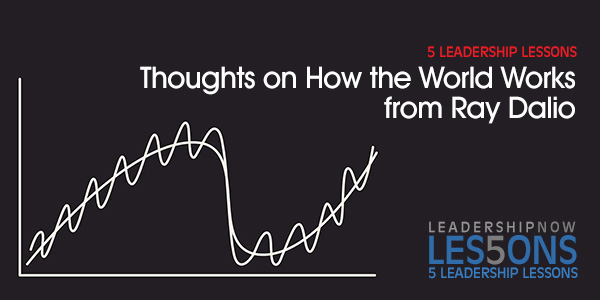
PRINCIPLES matter, and they are most readily seen in history. Sadly, many people today have not been exposed to thoughtful history if they have studied it at all. Many things change over time, but human nature doesn’t. It operates along predictable lines. And it is a mistake to ignore them. Ray Dalio examines history’s most turbulent economic and political periods in Principles for Dealing with the Changing World Order: Why Nations Succeed and Fail. What is significant is that what we have and will experience in our lifetimes has precedence in history. It has happened before in a similar pattern. He places these patterns in a framework that he calls the Big Cycle to illuminate the forces that have driven successes and failures throughout history. While there is much to learn in this book, I present five excerpts that and general in nature that we can use to challenge our thinking and use to make more thoughtful choices.
Here is a caution that applies to individuals, families, organizations, and nations: “History has taught us that when there are leadership transitions and/or weak leadership at the same time that there is big internal conflict, the risk of her enemy making an offensive move should be considered elevated.” 
Posted by Michael McKinney at 08:24 AM
03.03.22

Leading Thoughts for March 3, 2022
IDEAS shared have the power to expand perspectives, change thinking, and move lives. Here are two ideas for the curious mind to engage with: P. M. Forni on the art of going over your life: “You reflect to review the past, take stock of the present, and build a better future. The learning you acquire from reflecting on your experiences and those of others will depend on your willingness to ask yourself tough questions and to stick around for the uncomfortable answers. Here you must exercise caution. Do not dwell on the past unless you can learn from it. Do not look back to hurt yourself or others. The point is to use the past in ways that are beneficial to you.” Source: The Thinking Life: How to Thrive in the Age of Distraction Performance psychologist Jim Loehr on our moral operating system: “The combination of personal beliefs, ideology, and strong emotion can completely overwhelm our capacity for rational thought and sound judgment. Once we declare a belief to be unfettered truth, we close the door to introspective inquiry. Rather than using our powers of reason to investigate weaknesses and inconsistencies in what well could be a faulty belief, we instead use our capacity for creative logic to garner support for what our gut tells us to believe. Once a belief is successfully dressed up as truth, we feel justified in whatever moral judgment or decision we render.” Source: Leading with Character: 10 Minutes A Day to A Brilliant Legacy Look for these ideas every Thursday on the Leading Blog. Find more ideas on the LeadingThoughts index.
Posted by Michael McKinney at 07:34 AM
03.01.22

First Look: Leadership Books for March 2022Here's a look at some of the best leadership books to be released in March 2022. Be sure to check out the other great titles being offered this month.
What if the most powerful coach that could help you reach your own potential was actually...yourself? Take Charge Of You teaches you the secrets to self-coaching. Everyone could use a good coach to help them reach their full potential. Unfortunately, there just aren't enough good ones to go around, and the ones that exist are often too expensive or sought-after for most of us to even consider hiring them. But that doesn't mean you should go without! Your life is too important to leave your personal growth and professional development up to chance. Take Charge of You helps you define for yourself what you want out of life and give yourself what you need to succeed.
Leading to Greatness is a hands-on how-to leadership development program designed to guide leaders to self and organizational excellence. By applying five core leadership principles top-level executives will be primed to take their organizations and teams into the future. Principle 1: Define a crystal-clear understanding of values and purpose―and never deviate. Principle 2: Recognize core strengths and align them with passion. Principle 3: Identify and engage the right people and get them in the right seats; no leader excels at everything. Principle 4: Learn to manage energy―not time―to become fully engaged in life (and thus, leadership). Principle 5: Develop a consistent inner discipline to achieve exceptional results. Author Jim Reid combines his decades of top-level leadership and coaching experience with the best research and science available to deliver to leaders a practical and actionable plan that when consistently applied in one’s life becomes a transformative experience.
Discover true leadership with this actionable guide from a world renowned leadership expert, psychoanalyst, and executive coach. In Leading Wisely: Becoming a Reflective Leader in Turbulent Times, renowned leadership expert, psychoanalyst and executive coach Manfred Kets De Vries delivers an insightful and unique exploration of what it means to lead with wisdom. The book demonstrates that exclusive reliance on knowledge, data, and information yields a superficial leadership style lacking in depth and discernment. What's more important in the wisdom equation is possessing humility, judgment, empathy, compassion, and night vision.
The time-honored tradition of defining career development exclusively in terms of promotions, moves, and title changes is dead. Beyond, between, and besides the climb up the positional ladder, there are many other ways that employees can―and want to―grow. However, many organizations still operate under the notion that promotions are the only option for career development, leaving employees disengaged, managers frustrated, and the business disadvantaged in its efforts to retain talent. The good news is that career development is so much more than promotions alone, and managers are in a powerful position to redefine career development and create positive results for their employees and their organizations in this area. In Promotions Are So Yesterday, Julie Winkle Giulioni offers you a new approach for developing your employees' careers and helping them thrive in a company when promotions are not readily available. Discover an easy-to-apply framework of seven alternative dimensions of development that will engage your employees―dynamic opportunities for growth that are completely within your control as a manager.
From the world’s most influential management consulting firm, McKinsey & Company, an insight-packed, revelatory look at how the best CEOs do their jobs based on extensive interviews with today’s most successful corporate leaders—including chiefs at Netflix, JPMorgan Chase, General Motors, and Sony. Being a CEO at any of the world’s largest companies is among the most challenging roles in business. Billions, and even trillions, are at stake—and the fates of tens of thousands of employees often hang in the balance. Yet, even when “can’t miss” high-achievers win the top job, very few excel. Thirty percent of Fortune 500 CEOs last fewer than three years, and two out of five new CEOs are perceived to be failing within eighteen months. For those who shoulder the burden of being the one on whom everyone counts, a manual for excellence is sorely needed.
Feelings of loneliness among employees are on the rise with 72% of global workers suffering from it. This sense of isolation is contributing to a real and growing mental health problem that affects both individuals and organizations. In Connectable, you’ll learn how tackling the issue of worker loneliness head on can transform an isolated workforce into one that’s happier, more engaged, and more productive. With more than a decade of experience spent helping companies lessen worker loneliness, Ryan Jenkins and Steven Van Cohen distill their methodology, showing you what’s causing today’s loneliness, the role inclusion plays in solving it, and how you can decrease loneliness and increase belonging, engagement, and performance with employees at every level―including yourself.
 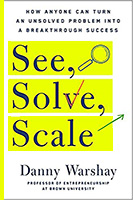 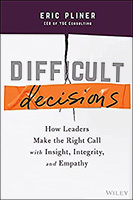
 Build your leadership library with these specials on over 28 titles. All titles are at least 40% off the list price and are available only in limited quantities. “He that loves a book will never want a faithful friend, a wholesome counselor, a cheerful companion, an effectual comforter. By study, by reading, by thinking, one may innocently divert and pleasantly entertain himself, as in all weathers, as in all fortunes.” — Isaac Barrow
Posted by Michael McKinney at 07:11 AM
|
BUILD YOUR KNOWLEDGE


How to Do Your Start-Up Right STRAIGHT TALK FOR START-UPS 
Grow Your Leadership Skills NEW AND UPCOMING LEADERSHIP BOOKS 
Leadership Minute BITE-SIZE CONCEPTS YOU CAN CHEW ON 
Classic Leadership Books BOOKS TO READ BEFORE YOU LEAD |
|